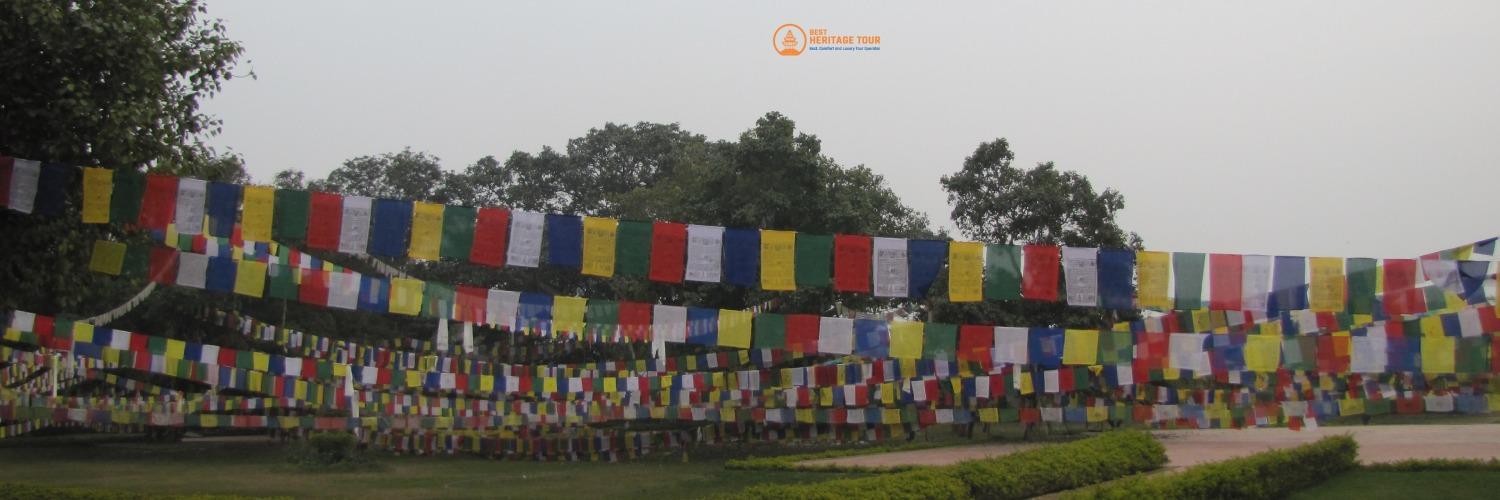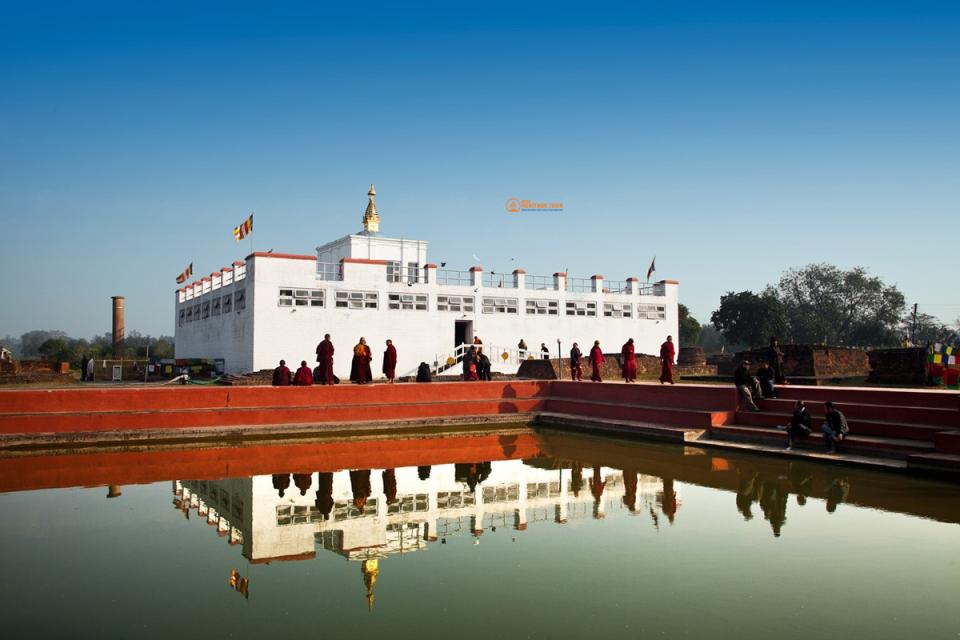Nestled in the quiet plains of southern Nepal, Lumbini stands as one of the most sacred and serene places on Earth. This peaceful town, located in the Rupandehi District near the Indian border, is celebrated as the birthplace of Lord Siddhartha Gautama, who later became the Buddha - the Enlightened One.
For more than 2,600 years, Lumbini has drawn pilgrims, travelers, and seekers of peace from around the world. The gentle sound of chanting monks, fluttering prayer flags, and golden spires rising against the blue sky create a sense of tranquility that touches every visitor’s heart.
Whether you’re a spiritual traveler, history enthusiast, or simply someone searching for inner calm, Lumbini offers an unforgettable experience. This guide will take you through everything you need to know before visiting the sacred birthplace of Buddha - from its history and main attractions to travel tips and the best way to explore it with a guided tour.
The Sacred History of Lumbini
Lumbini’s story dates back to around 563 BCE, when Queen Maya Devi of the Shakya dynasty stopped here on her way to her maternal home in Devadaha. It was under a sal tree in Lumbini that she gave birth to Prince Siddhartha Gautama, who would later renounce worldly life and attain enlightenment to become the Buddha.
Recognizing its spiritual importance, Emperor Ashoka of India visited Lumbini in 249 BCE. He erected the famous Ashokan Pillar, engraved with inscriptions that confirmed this as the birthplace of Buddha. Over centuries, monasteries and stupas were built around the sacred site, and today, Lumbini is a UNESCO World Heritage Site, symbolizing peace, compassion, and spiritual awakening.
Major Attractions in Lumbini You Shouldn’t Miss
Lumbini is divided into several zones - the Sacred Garden, the Monastic Zone, and the New Lumbini Village - each offering something unique for visitors.
Here are the most important places to explore during your visit:
1. Maya Devi Temple
At the heart of Lumbini lies the Maya Devi Temple, marking the exact spot where Lord Buddha was born. Inside, an ancient marker stone identifies the sacred birthplace, surrounded by ruins of stupas and brick structures from different eras.
Pilgrims light butter lamps, meditate, and offer prayers in silence here. The serene Sacred Garden surrounding the temple is filled with prayer flags fluttering in the wind - a true embodiment of peace and faith.
2. The Ashokan Pillar
Erected by Emperor Ashoka, this ancient sandstone pillar carries an inscription written in Brahmi script confirming Buddha’s birthplace. It stands as historical proof of Buddhism’s deep roots and the emperor’s devotion to spreading Buddha’s message of peace.
3. The Sacred Pond (Puskarini)
Located next to the Maya Devi Temple, this tranquil pond is believed to be where Queen Maya Devi bathed before giving birth and where the newborn Prince Siddhartha was given his first purification bath. The calm reflection of the temple on the pond’s surface adds to its spiritual charm.
4. World Peace Pagoda (Japanese Peace Stupa)
Built by Japanese Buddhists, the World Peace Pagoda is one of the most iconic structures in Lumbini. Its gleaming white dome represents global harmony and enlightenment. A golden statue of Buddha inside the stupa depicts him in a meditative pose, inviting peace into the hearts of all who visit.
5. Monastic Zone
Lumbini’s Monastic Zone is a vast area divided by a long central canal, with monasteries built by Buddhist communities from around the world. Each monastery reflects its country’s unique architectural style and interpretation of Buddhism.
Some notable monasteries include:
-
Royal Thai Monastery - Elegant white marble structure symbolizing purity
-
Chinese Monastery - Traditional design with red pillars and golden roofs
-
German Monastery (Lotus Stupa) - Peaceful retreat featuring intricate murals
-
Korean Monastery - Minimalist architecture dedicated to meditation and simplicity
-
Myanmar Golden Temple - Radiant golden pagoda inspired by Burmese temples
Walking through this zone feels like taking a spiritual journey across Asia - each monastery offering a glimpse into how Buddhism flourished in different cultures.
6. Lumbini Museum
For those who wish to explore the archaeological and historical significance of the site, the Lumbini Museum displays artifacts, sculptures, coins, and ancient manuscripts related to Buddha’s life and the early spread of Buddhism. It’s a must-visit for anyone seeking to understand Lumbini beyond its spiritual aura.
7. Eternal Flame
The Eternal Peace Flame was lit in 1986 to commemorate world peace and brotherhood. It continues to burn as a reminder of Buddha’s timeless message of non-violence and compassion.
8. Tilaurakot - The Kingdom of Kapilavastu
Located about 27 km from Lumbini, Tilaurakot is believed to be the ancient palace where Prince Siddhartha spent the first 29 years of his life before setting out on his quest for enlightenment. The archaeological ruins and museum here provide an intimate look at the Buddha’s royal beginnings.
Best Time to Visit Lumbini
Lumbini can be visited throughout the year, but the best time is during the cooler months from October to March. The skies are clear, temperatures are pleasant, and outdoor exploration becomes more enjoyable.
If you visit in May, you can witness the grand Buddha Jayanti Festival, which celebrates the birth, enlightenment, and death of Lord Buddha - all believed to have occurred on the same day of the full moon in the month of Vaisakha.
How to Reach Lumbini
By Air:
The nearest airport is Gautam Buddha International Airport in Bhairahawa (around 22 km from Lumbini), which has regular flights from Kathmandu and international connections to India and other nearby countries.
By Road:
Lumbini is easily accessible by road from major Nepali cities like Kathmandu (8-9 hours) and Pokhara (6-7 hours). Comfortable tourist buses and private vehicles are available.
By Train (via India):
Travelers from India can take a train to Gorakhpur or Sunauli Border, then continue by road to Lumbini.
Accommodation and Travel Tips
Lumbini offers a range of accommodations - from budget guesthouses to mid-range hotels and luxury resorts. Many monasteries also provide simple lodging for pilgrims and meditators seeking a peaceful retreat.
Travel Tips:
-
Dress modestly and respectfully in monasteries and temples.
-
Maintain silence in sacred areas to preserve the peaceful environment.
-
Carry light, breathable clothing if visiting in summer.
-
Always stay hydrated and wear comfortable shoes for long walks in the monastic zone.
-
Early morning and sunset are ideal times for photography and meditation.
Why Choose a Guided Lumbini Tour?
While exploring Lumbini on your own can be enriching, joining a guided tour ensures you gain a deeper understanding of its sacred history and symbolism. A local expert can explain the meaning behind each monument, guide you through lesser-known sites, and handle all logistics - allowing you to focus purely on your experience.
With Best Heritage Tour, your journey to Lumbini becomes more than sightseeing. You’ll be guided by professionals who understand both the spiritual and cultural importance of the site. Whether you want a short 2-day visit or an extended Buddhist Circuit Tour covering Lumbini, Kapilavastu, and Bodhgaya, we’ll craft an experience that resonates with your spiritual goals.
Conclusion
Lumbini is not just the birthplace of Lord Buddha - it is the birthplace of peace, compassion, and wisdom. Every stone, every prayer flag, and every monastery whispers stories of enlightenment that continue to inspire millions of hearts across the world.
Walking through Lumbini, you don’t just explore a destination; you experience a transformation - one that invites you to slow down, reflect, and reconnect with your inner self.
Plan your journey to Lumbini today with Best Heritage Tour - your trusted travel partner in Nepal.
Let us help you discover the divine tranquility of the Buddha’s birthplace and the essence of peace it offers to every soul who visits.
Phone / WhatsApp / Viber: +977-9851149197 | +977-9810043046
Email: info@bestheritagetour.com | bestheritagetour@gmail.com
Info & Booking: www.bestheritagetour.com
Office: Thamel Marg, Kathmandu, Nepal
Author: Best Heritage Tour
Date: 14th October, 2025


